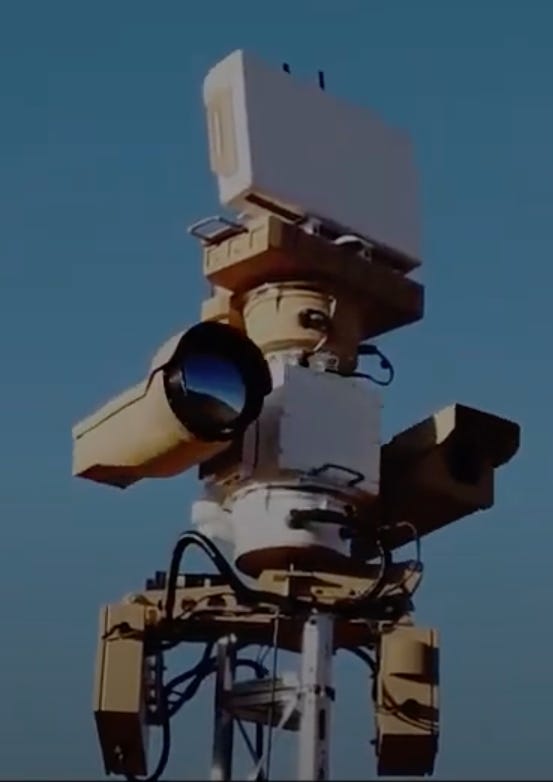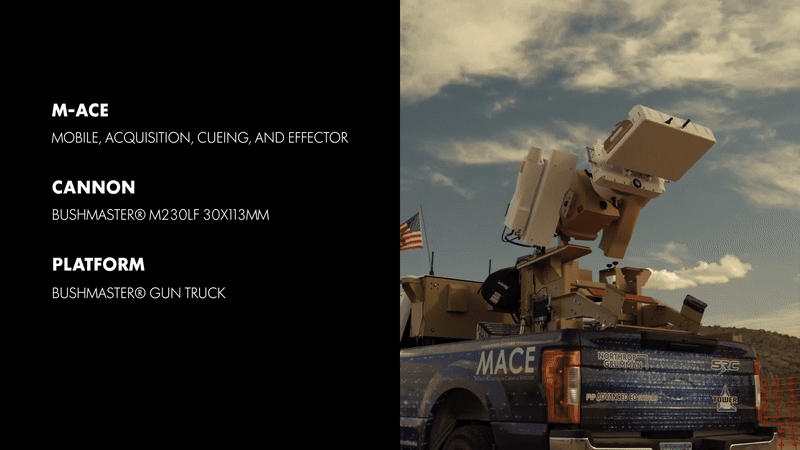This is one of the most advanced Counter-Unmanned Aerial Systems (C-UAS) Ukraine is Using RIGHT NOW.
The Mobile Acquisition Cueing and Effector (M-ACE) system uses reliable, proven components with advanced technologies like AI and Open-Architectures that enable expandability and future-proofing.
The Engineer's Perspective is a reader-supported publication. Sign and up and subscribe to see more in-depth Aerospace/Aeronautical Analysis!
Table of Contents:
Overview
Key Features
Comparisons to Other Systems
Specifications
Concept of Operations
Systems Engineering Requirements
Implications and Future Considerations
Conclusion
References
Overview:

The Mobile Acquisition Cueing and Effector (M-ACE) system is a tactical counter-unmanned aircraft system (C-UAS) developed by Northrop Grumman Armament Systems. It provides a comprehensive solution for detecting, tracking, and neutralizing unmanned aerial threats.
Key features of the M-ACE system include:
Modular and adaptable design that can be mounted on various commercial and military vehicle platforms, including standard 8' truck beds.
Advanced sensor suite comprising:
3D radar (White Gryphon R1400)
Electro-optical/infrared (EO/IR) cameras
Radio frequency (RF) sensors
GPS
Secure radio for data transmission
Open-architecture command and control (C2) software that supports industry protocols and integrates with numerous sensors and cameras.
Advanced predictive cueing capability using artificial intelligence and machine learning to shorten the kill chain decision cycle.
Ability to cue various kinetic, non-kinetic, and directed energy effectors, including 30mm Bushmaster auto-cannons (M230LF or XM813).
Networked integration with other defense systems, such as Scorpion air defense vehicles.
Power options including vehicle alternator, hydrogen fuel cells, solar power, and shore power.
The M-ACE system is designed to provide a mobile, rapidly deployable C-UAS capability for various applications, including battlefield operations, border surveillance, and critical infrastructure protection. Its advanced sensor fusion and autonomous capabilities enable near machine-speed target identification, classification, and prioritization, making it an effective solution for addressing the growing threat of unmanned aerial systems.
Sensor Fusion:

Similar to the F-35's utilization of its multiple sensors, M-ACE integrates multiple sensor types, including 3D radar, electro-optical/infrared cameras, and radio frequency detectors, enabling comprehensive threat detection across various drone types:
3D Radar: The M-ACE system utilizes the White Gryphon R1400 3D radar, which sits atop a 30-foot tower rising from the vehicle bed. This radar provides:
360-degree coverage for detecting aerial and ground threats
Ability to pinpoint the precise position of detected assets
Detection range of up to 10 km for small UAS and 27 km for small manned aircraft
Electro-Optical/Infrared (EO/IR) Cameras: M-ACE employs a CDC Nikon camera system with both infrared and visible spectrum capabilities. These cameras offer:
Visual confirmation of detected threats
Day and night operation capabilities
Laser rangefinders for autonomous camera positioning towards detected threats
Radio Frequency (RF) Sensors: These sensors allow the system to detect and analyze drone control signals, providing:
Ability to identify and classify different types of unmanned systems
Enhanced early warning capabilities
Sensor Fusion Integration through AI:

The these sensors when used together create multiple streams of data that need to be integrated together to form a cohesive picture for situational awareness. To perform this integration, M-ACE utilizes the M-ACE C2 software, an open-architecture software system that leverages AI and ML plug-ins to enhance its capabilities. Developed by Northrop Grumman. The resulting sensor fusion integration enables:
Rapid threat detection, identification, and tracking
Near machine-speed decision-making for target prioritization
Ability to handle multiple simultaneous targets
By utilizing AI to enhance the integration M-ACE benefits through:
Compressed decision cycles
Improved target identification and classification
Adaptive threat response based on evolving scenarios
Software Details
Key characteristics of M-ACE C2 software include:
Integration capabilities:
Supports all major industry protocols: The software is designed to be compatible with a wide range of industry-standard communication protocols, ensuring seamless integration with existing military and civilian infrastructure. This includes protocols for data exchange, command and control, and sensor communication.
Integrates with hundreds of sensors and cameras: M-ACE C2 can incorporate data from a vast array of sensor types, including but not limited to radar systems, electro-optical/infrared cameras, radio frequency detectors, and acoustic sensors. This multi-sensor approach enables a comprehensive threat detection capability.
Exceptional reliability: The software is engineered to maintain high performance and stability even in challenging operational environments, ensuring consistent functionality during critical missions.
Advanced autonomy and AI:
Leverages advanced man-in-loop autonomy: The system combines autonomous decision-making capabilities with human oversight, allowing for rapid responses while maintaining human control over critical decisions. This balance ensures both speed and accountability in threat response.
Incorporates Artificial Intelligence and Machine Learning (AI/ML) plug-ins: These advanced algorithms enable the system to learn from experience, improving threat detection and classification over time. AI/ML capabilities can help identify patterns in drone behavior, predict potential threats, and optimize system performance.
Compresses the decision cycle for faster threat response: By automating certain processes and providing rapid data analysis, the AI-enhanced system significantly reduces the time between threat detection and response, crucial in countering fast-moving drone threats.
Threat management:
Rapidly identifies targets: Utilizing its multi-sensor data fusion and AI capabilities, the system can quickly detect and identify potential threats in the operational environment.
Classifies threats: Once a target is identified, the system assesses its characteristics to determine the level of threat it poses. This classification process helps prioritize responses and allocate resources effectively.
Cues effectors for engagement: Based on the threat classification, M-ACE C2 can automatically suggest or initiate appropriate countermeasures, which may include jamming, directed energy weapons, or kinetic interceptors.
Adaptability:
Exportable system: The software is designed to be easily deployable across different platforms and operational environments, making it suitable for various military and civilian applications.
Software Development Kit (SDK) available: Northrop Grumman provides an SDK to partners, allowing them to customize and extend the system's capabilities. This enables the integration of specialized sensors, effectors, or analytical tools to meet specific operational needs.
Continuous learning:
Continually adds identifying factors: The system's database of UAV signatures is constantly updated with new information gathered from operational experiences and intelligence sources. This includes characteristics such as flight patterns, radio emissions, and visual signatures.
Enables rapid Identification Friend or Foe (IFF) capabilities: By maintaining an up-to-date database of both friendly and hostile UAV characteristics, the system can quickly distinguish between allied drones and potential threats, reducing the risk of friendly fire incidents.
These advanced features make the M-ACE C2 software a powerful and flexible tool in the rapidly evolving field of counter-UAS operations, capable of adapting to new threats and operational requirements, by using this AI-enhanced tool with a multi-sensor approach, M-ACE can provide a comprehensive, real-time picture of the battlespace, detecting and tracking various types of threats from small drones to ground targets. The system's ability to rapidly process and fuse data from multiple sensors enables it to overcome the challenges posed by small, agile tactical unmanned vehicles, providing a robust counter-UAS capability.
Rapid response capability:
M-ACE's advanced predictive cueing and AI-driven target identification allow for near machine-speed decision-making, and is a critical feature in modern counter-UAS operations, particularly in addressing the challenges posed by agile and swarm-based drone tactics observed in Ukraine. This capability is built on two key components:
Advanced Predictive Cueing
AI-Driven Target Identification
Keep reading with a 7-day free trial
Subscribe to The Engineer's Perspective to keep reading this post and get 7 days of free access to the full post archives.





